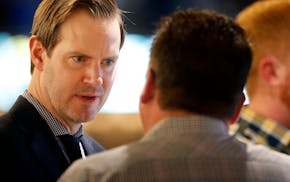A second unveiling of a bronze statue took place Saturday at Target Field. This was in honor of Harmon Killebrew, the first star and the first Hall of Famer for the Twins.
Killebrew has shifted his weight and is getting full extension on a swing intended to send a baseball into orbit.
Bert Blyleven, the next player likely to be wearing a Twins cap on a plaque in Cooperstown, N.Y., had perused the Killebrew statue that stands at the front of the ballpark's plaza.
"It doesn't look like Harmon was trying to use the whole field," someone said.
Blyleven laughed and said: "That probably would get him in trouble with today's coaches. It was a beautiful thing to see him swing."
Just as Rod Carew did for his statue, Killebrew posed for hundreds of photos for sculptor Bill Mack. The assumption was that the prototype for this swing came from the weekend of June 3-4, 1967.
On that Saturday, Killebrew became the first player to reach Met Stadium's second deck with a three-run homer off California's Lew Burdette. On that Sunday, he hit a home run off the Angels' Jack Sanford that went farther to left-center and caromed off the façade of the second deck.
Neither of these monster shots was the source of Mack's creation. "It's the home run I hit off Jim Maloney in the All-Star Game," Killebrew said.
That would be the 1965 game at Met Stadium, where the American League lost 6-5 to a National League team that had the best collection of talent in the history of the grand old game.
Whenever anyone wants to argue that point, they are given this fact: Frank Robinson, Roberto Clemente and Billy Williams were backup outfielders for the NL.
There was a chance to watch a player of similar greatness invade Minnesota over the past two days. The games were exhibitions and the focus was on the Twins' spectacular new ballpark, yet hardcore fans had to be talking about the Cardinals' Albert Pujols as they left Target Field.
On Friday, Pujols hit a drive to right-center field that he admired for a moment. The wind held it up and center fielder Denard Span made a running catch. Pujols followed that with a single, a hard-hit out and a walk.
On Saturday, Pujols smacked a double to left, lined out to left and then hit a fly ball in the sixth that Delmon Young caught on the warning track.
Pujols put the ball in play six times in two games and there wasn't a soft out in the bunch. His strength, the foundation he creates and the ability to stay back before committing make him a phenomenon for the ages.
He won his third MVP award since 2005 for the Cardinals last season. He's the only player in big league history to have 30 or more home runs in his first nine seasons. And, for active players with 6,000 at-bats, his average of .334 is one point higher than slap-hitting Ichiro Suzuki.
Ten years from now, someone will write an early history of Target Field and a large deal will be made that Pujols made his first Minnesota appearance in this ground-breaking exhibition series.
Kevin Slowey gave up the double, the line out and the high fly to Pujols on Saturday.
"That fly ball carried farther than I thought," Slowey said. "Did you think it was going out? I knew he didn't get it."
Slowey knew because he gave up a pair of home runs to Pujols last June in St. Louis. It was Slowey's second-to-last start of 2009 before he underwent wrist surgery.
"[Pujols] looks like he's swinging with a tennis racquet," Twins manager Ron Gardenhire said. "He just looks like a guy that's going to get a hit."
The Twins' Michael Cuddyer said: "If I was a pitcher, I wouldn't have any idea what to do. I'd throw four pitches in the dirt, hoping he would swing at three of them.
"And Albert wouldn't, which is why they had to give Matt Holliday $100 million to hit behind him."
Years from now, the first fans at the new ballpark will see it as their privilege to have watched Albert Pujols assist in the christening of Target Field.
Patrick Reusse can be heard noon-4 weekdays on AM-1500 KSTP. • preusse@startribune.com

Reusse: How bad are the White Sox? They made Twins look good.

Reusse's Tortured Columnist Department update: Yes, Vikings won the offseason

Reusse: Wolves need stopper for Booker? NAW, it's not a problem.

Reusse: Success on court helped Timberwolves do strong business


